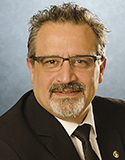Page Content
 It’s time to tone down the extreme rhetoric that’s pervading discussions around gender minorities, said Alberta Teachers’ Association president Mark Ramsankar in the wake of reaction to new LGBTQ guidelines released by the province.
It’s time to tone down the extreme rhetoric that’s pervading discussions around gender minorities, said Alberta Teachers’ Association president Mark Ramsankar in the wake of reaction to new LGBTQ guidelines released by the province.
On Jan. 13, the government released a set of 12 guidelines aimed at helping school boards formulate policies to ensure their schools are caring and safe places that respect diverse sexual orientations, gender identities and gender expressions.
On Jan. 19, Ramsankar released a statement describing some of the subsequent reaction as “extreme rhetoric” that is “very unhelpful.”
“I have heard people describing as ‘totalitarian’ and ‘bullying’ the government’s efforts to identify ways in which schools can be made more welcoming for transgender students,” Ramsankar said. “I have also heard unwarranted attacks upon the legitimacy of Catholic education and calls for the abolition of a school system that we fully support ... none of this contributes to a civil dialogue.”
He noted that the Catholic school system has served Alberta communities since before the province was created.
Among the guidelines, which aren’t legally binding, are calls to respect an individual’s right to self-identification and to handle school records and dress codes in a way that respects gender identity. Also included are recommendations to minimize the amount of gender-segregated activities, and provide sexual and gender minorities with access to the washrooms and change rooms of their choice, as well as full, safe and equitable participation in curricular and extracurricular activities.
To Ramsankar, some of the criticism being published includes misrepresentations that “would be laughable if they were not so hurtful.”
“We have people who are imagining the most bizarre scenarios — they seem to believe that the use of the words ‘mother’ and ‘father’ will somehow be banned or that the consequence of accommodating a few transgender students will be that teen boys will be traipsing at will through the girls’ change room (or vice versa) when the intention is clearly to support those students who face the wrenching challenges of navigating through the world when their gender identity does not match their sex.”
Endorsement
Ramsankar said the Association welcomes the guidelines.
“For me and my members, whether they teach in Catholic, public or francophone schools, this is all about helping us to meet our professional and legal obligations to ensure that our classrooms are safe and caring places of learning for every student,” he said.
In light of the new guidelines, as school communities determine how they can better meet the needs of students and their families, teachers welcome thoughtful conversations, Ramsankar said.
“I am not naive — there will be times when well-intentioned people will disagree, but when that happens we must agree to remain respectful and considerate of each other and recall that the first priority of the school is to nurture all its students and staff.”
Education Minister David Eggen has given school boards until March 31 to create policies to ensure their schools are “welcoming, caring, respectful and safe.” ❚
Guidelines for supporting students and staff with diverse sexual orientations, gender identities and gender expressions
- Providing supports that respond to a student’s individual needs.
- Respecting an individual’s right to self-identification.
- Maintaining school records in a way that respects privacy and confidentiality.
- Ensuring dress codes respect an individual’s gender identity and gender expression.
- Minimizing gender-segregated activities.
- Enabling students with diverse sexual orientations, gender identities and gender expressions to have full, safe and equitable participation in curricular and extracurricular activities.
- Providing safe access to washroom and change room facilities.
- Providing professional learning opportunities that build the capacity of staff to understand and support diverse sexual orientations, gender identities and gender expressions.
- Using a comprehensive whole-school approach to promote healthy relationships and prevent and respond to bullying behaviour.
- Ensuring students have the understanding, skills and opportunities to contribute to welcoming, caring, respectful and safe learning environments that respect diversity and nurture a sense of belonging and positive sense of self.
- Ensuring all families are welcomed and supported as valued members of the school community.
- Ensuring that school staff have work environments where they are protected from discrimination based on their sexual orientations, gender identities and gender expressions.
Source: Alberta Education
